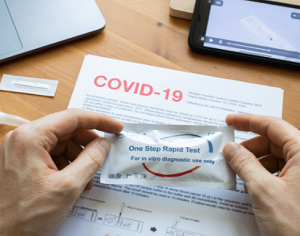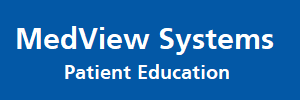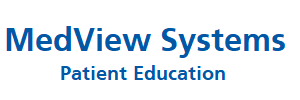

CDC Tests for COVID-19
CDC has developed a new laboratory test kit for use in testing patient specimens for severe acute respiratory syndrome coronavirus 2 (SARS-CoV-2), the virus that causes COVID-19. The test kit is called the “Centers for Disease Control and Prevention (CDC) 2019-Novel Coronavirus (2019-nCoV) Real-Time Reverse Transcriptase (RT)-PCR Diagnostic Panel.” It is intended for use with the Applied Biosystems 7500 Fast DX Real-Time PCR Instrument with SDS 1.4 software.
This test is intended for use with upper and lower respiratory specimens collected from persons who meet CDC criteria for COVID-19 testing. CDC’s test kit is intended for use by laboratories designated by CDC as qualified, and in the United States, certified under the Clinical Laboratory Improvement Amendments (CLIA) to perform high complexity tests.
The test kits also will be shipped to qualified international laboratories, such as World Health Organization (WHO) Global Influenza Surveillance Response System (GISRS) laboratories. The test will not be available in U.S. hospitals or other primary care settings. The kits will be distributed through the International Reagent Resourceexternal icon (IRR)
Demonstration Videos
CDC–NIH Initiative Provides Free COVID-19 Rapid Home Tests In North Carolina, Tennessee
Rachael L. Fleurence
Elizabeth A. DiNenno
William T. Riley
Matthew J. McMahon
Michael S. Lauer
OCTOBER 27, 202110.1377/hblog20211025.437195
In the US, more than 43.6 million people have been infected with the SARS-CoV-2, the virus that causes COVID-19 and more than 700,000 died, with infections and deaths disproportionally affecting populations that have been historically marginalized. Rapid antigen home tests (also known as self-tests) hold the promise of providing a relatively easy-to-use method for detecting people with symptomatic and asymptomatic SARS-CoV-2 infection, with or without known or suspected exposure.
Antigen tests, which can return results in as little as 15 minutes, detect protein fragments specific to a virus. By comparison, reverse transcription-polymerase chain reaction (RT-PCR) tests, which generally take days to return results, detect genetic material (such as RNA) specific to a virus. Data have suggested the equivalent sensitivity of some rapid antigen tests (of which antigen home-tests are one type) to RT-PCR, when used two to three times a week.
In March 2021, the Food and Drug Administration (FDA) authorized several COVID-19 tests for screening—that is, testing individuals with or without the presence of symptoms—on a regular basis. Scientific opinions have at times differed with respect to the benefits of rapid antigen tests compared to RT-PCR. Models have shown that at the population level, test frequency and rapidity of results might be more important than high sensitivity to reduce transmission of SARS-CoV-2.
Large-scale rapid antigen testing at home has not been widespread nationally. Internationally, screening pilots using rapid point-of-care antigen tests have been conducted in the United Kingdom where the government subsequently expanded the free rapid test program to residents in England. To date, rapid antigen home-test programs to promote communitywide, frequent screening have not been systematically implemented in the US, so their impact on COVID-19 prevention and control is still being explored. A key question is whether the availability of frequent screening for entire communities can help break the chains of transmission. Other questions, such as whether the public will accept the tests, use them frequently, and take appropriate measures such as isolation or quarantining if the test is reactive, remain unanswered.
CDC And NIH Launch First Rapid Testing At-Home Programs In Two Communities
On March 31, 2021, the Centers for Disease Control and Prevention (CDC) and the National Institutes of Health (NIH), in coordination with state and local public health departments and collaboration with other partners, announced a joint initiative called “Say Yes! COVID Test” (SYCT), which aimed to distribute up to two million rapid antigen tests in Pitt County, North Carolina and Hamilton County, Tennessee. The SYCT partners include the University of North Carolina at Chapel Hill (UNC), Duke University, the Duke Clinical Research Institute, the University of Massachusetts, Community Campus Partnerships for Health (CCPH), and CareEvolution. The program has since expanded to communities in Michigan, Georgia, and Hawaii.
Test kits were available in two ways: online ordering and direct shipment to residents’ homes through a partnership with Amazon or local pick-up sites, such as churches, schools, and local centers. A public health campaign to promote the program was also launched with TV, radio, and social media advertising, as well as direct mailers to households. Each test kit contained 25 individual Quickvue tests from Quidel, provided through the NIH’s RADx program, allowing two people to test three times a week for four weeks. A digital assistant was developed by CareEvolution that provided test instructions and allowed users to opt-in to receive reminders to test. In Hamilton County, Tennessee, residents could elect to submit their test results to the state public health authority through the digital assistant.
The project underwent human subjects review at the CDC and received a non-research determination, and by the Duke University and University of North Carolina Institutional Review Boards. In both counties, residents could also opt-in to a separate research study requiring individual consent to respond to periodic survey questions on testing experiences through the digital assistant; this study was approved by the Institutional Review Board of Duke University and UNC. A significant effort was led by the CCPH to reach out to local Black and Hispanic communities, as well as other groups identified by the local public health departments to be at higher risk for COVID-19. Residents who wished to, were able to receive and use tests without any digital participation. Exhibit 1 provides information on the timing and distribution of kits.
Exhibit 1: Distribution of test kits by county (1 test kit = 25 home tests).
Source: Census Bureau and Duke Clinical Research Institute.
Learnings From The SYCT Initiative
To capture key lessons learned, Research America conducted a market research survey in Pitt County, North Carolina, between May 10 and May 19, 2021, and in Hamilton County, Tennessee, between May 25 and June 8, 2021, each with nonprobabilistic samples of 400 respondents ages 18 years and older, stratified by sex, age, and race and ethnicity to reflect local population. While not statistically representative of the overall populations or subpopulations, the surveys were designed to capture attitudes to home tests and to the SYCT initiative. Respondents were interviewed by phone for 10 minutes.
A total of 79.8 percent of respondents in Pitt County, North Carolina, and 74.8 percent in Hamilton County, Tennessee, were aware of the availability of COVID-19 tests for home use. In both counties, the main concern about home-use tests was that they might not be as accurate as laboratory tests (44.8 percent in Pitt County, North Carolina, and 52.3 percent in Hamilton County, Tennessee). In total, only 9.5 percent of Pitt County, North Carolina, residents and Hamilton County, Tennessee, residents expressed concern about privacy of test results.
A little more than half of the survey respondents in both Pitt County, North Carolina (52.5 percent) and Hamilton County, Tennessee (51.0 percent) were aware that they could receive free home-use tests through the SYCT initiative in their county. In both counties, awareness was highest among Black respondents (64.3 percent in Pitt County, North Carolina, and 56.0 percent in Hamilton County, Tennessee). Of those surveyed, 17.8 percent in Pitt County, North Carolina, and 16.5 percent in Hamilton County, Tennessee, had received a SYCT test kit. Participation in the home-test program was highest among Black respondents with 29.4 percent in Pitt County, North Carolina, and 29.3 percent in Hamilton County, Tennessee, having received kits.
The majority of study participants in both counties reported the tests were very easy, or easy, to use (76.1 percent in Pitt County, North Carolina, and 90.2 percent in Hamilton County, Tennessee). However, only 11.3 percent in Pitt County, North Carolina, and 12.1 percent in Hamilton County, Tennessee, reported actually using the tests two to three times a week as indicated by the information accompanying the test kit, signaling that more effort is needed to understand and overcome barriers to frequent use.
Of those who had not received a kit, 40.7 percent in Pitt County, North Carolina, and 33.2 percent in Hamilton County, Tennessee, preferred not to receive a kit at all. Participants reported the main reason for not wanting a kit was having been vaccinated. Online ordering was the preferred option to receive kits for those who had not yet received a kit, with 26.4 percent preferring online ordering in Pitt County, North Carolina, and 41.0 percent in Hamilton County, Tennessee. Based on the survey results, online test ordering seems to be a promising approach, although alternatives should continue to be provided for those who cannot use, or do not want to use, the internet. In both Pitt County, North Carolina, and Hamilton County, Tennessee, local, on-the-ground distribution by trusted community leaders was an important component for local organizations representing persons of color. In all, 52 percent of kits distributed in Pitt County, North Carolina, and 63 percent in Hamilton County, Tennessee, were through local organizations (exhibit 1). The CCPH team was instrumental in engaging local leaders, such as pastors, education board members, and other critical stakeholders, many of whom contributed their own time and resources to make these test kits available to their communities.
A longer-term ecological evaluation is evaluating the impact of the test distribution on SARS-CoV-2 transmission through public health data and measures of SARS-CoV-2 in local wastewater. Results are expected at the end of 2021.
Future Of Rapid Home-Tests In The United-States
With 65 percent of the total US population fully vaccinated, and an overall decrease in national prevalence, hospitalizations, and deaths—after recent surges related to the Delta variant—the United States is entering a new phase of the pandemic (although the SYCT states North Carolina and Tennessee continue to be below the national average vaccination rate). Lessons from the implementation of the SYCT initiative should inform future testing policy and strategies. Large-scale provision of rapid home-tests to high-risk communities across the United-States could be an important tool in managing community transmission of SARS-CoV-2. Access to rapid tests for the public could continue to be an important mitigation measure under several scenarios, and indeed, the administration has recently made several important announcements on the efforts to increase the supply of rapid tests in the United States.
First, while the number of vaccinated people continues to increase, there remains a significant number of unvaccinated people across the United States and widespread geographical differences in vaccination rates. As the country enters into the late fall of 2021, strategies that offer protection to populations with higher risk of adverse COVID-19 outcomes (for example, unvaccinated groups, including children younger than age 12, occupations that place workers at higher-risk, and so forth) might benefit from frequent testing at home to manage hyperlocal outbreaks. Second, high-risk congregate settings, such as health care facilities, nursing homes, independent living facilities, shelters, jails, and prisons might consider providing rapid home-tests to their staff, residents, or clients to increase the level of protection. Finally, individuals and families may wish to continue testing in certain circumstances to guide their individual behaviors, if local transmission rates are higher, or when returning from travel from a higher-risk location. These home-test benefits would be most robust if test developers follow the FDA’s guidance to monitor the impact of new and emerging viral mutations and variants on the performance of their tests.
Important learnings from the SYCT initiative, including public attitudes and participation might guide future thinking around the provision of home testing. First, even with free tests, interest was mixed, with a third of test kits left over in Pitt County, North Carolina, and survey results indicating that segments of the population were not interested in receiving home kits at the time of the initiative. While this is in part attributable to increasing feelings of safety post-vaccination and prior to the data that has emerged on breakthrough infections, this was not the only reason people expressed lack of interest in testing. Additionally, the current approximate retail cost of $12 is likely to be a barrier for frequent asymptomatic testing. Recently, the Biden administration has announced agreements with large retailers to decrease the cost of rapid tests to consumers.
Second, public awareness of the usefulness of such tests, how to use them, how they differ from RT-PCR tests, and how they should be used as the COVID-19 landscape is rapidly changing in the United States, but continued public education and messaging will be required for those interested in this approach. One interpretation to explain the low numbers of people using the test 2–3 times a week could be that the concept of screening at home several times a week is a departure from the traditional diagnostic use, which for COVID-19 and many other diseases has historically largely been conducted under health care professional supervision. Interestingly, in both counties, residents reported that the ability to share test results with their health care professional made no difference in their interest in receiving at-home tests.
Third, the online ordering seemed to be the preferred mode of receiving tests, but local community distribution remained an important pathway. Black and Hispanic respondents had higher levels of participation in SYCT than White respondents, using both online ordering and traditional pick-up options at local sites. Ensuring multiple distribution options are available is an important lesson for local public health departments planning such projects in the future.
Summing Up
The expansion of screening tests into the home is a novel development. How large-scale deployment to whole communities could be implemented in this phase of the national COVID-19 response is still being evaluated. Lessons from the SYCT initiative might be used to plan for ways to distribute tests to communities, including understanding differences in preferences and interest by race, ethnicity, age, socioeconomic status, and vaccination status (age, socioeconomic status, and vaccination status results not reported here). Rapid at-home tests that have been demonstrated to be sensitive for COVID-19 could continue to play an important role in this next phase of the pandemic in the United States by helping manage the transmission of SARS-CoV-2 in unvaccinated populations and high-risk settings and assisting individual decision making.
Finally, the expansion of home tests for screening purposes to other seasonal respiratory infectious diseases such as influenza will be an interesting area to explore.
Recommendations
CDC Recommends
- Everyone can do their part to help us respond to this emerging public health threat:
- Individuals and communities should familiarize themselves with recommendations to protect themselves and their communities from getting and spreading respiratory illnesses like COVID-19.
- Older people and people with severe chronic conditions should take special precautions because they are at higher risk of developing serious COVID-19 illness.
- If you are a healthcare provider, be on the look-out for:
- People who recently traveled from China or another affected area and who have symptoms associated with COVID-19, and
- People who have been in close contact with someone with COVID-19 or patients with pneumonia of unknown cause. (Consult the most recent definition for patients under investigation [PUIs].)
- If you are a healthcare provider or a public health responder caring for a COVID-19 patient, please take care of yourself and follow recommended infection control procedures.
- If you are a close contact of someone with COVID-19 and develop symptoms of COVID-19, call your healthcare provider and tell them about your symptoms and your exposure. They will decide whether you need to be tested, but keep in mind that there is no treatment for COVID-19 and people who are mildly ill are able to isolate at home.
- If you are a resident in a community where there is ongoing spread of COVID-19 and you develop COVID-19 symptoms, call your healthcare provider and tell them about your symptoms. They will decide whether you need to be tested, but keep in mind that there is no treatment for COVID-19 and people who are mildly ill are able to isolate at home.
- For people who are ill with COVID-19, but are not sick enough to be hospitalized, please follow CDC guidance on how to reduce the risk of spreading your illness to others. People who are mildly ill with COVID-19 are able to isolate at home during their illness.
- If you have been in China or another affected area or have been exposed to someone sick with COVID-19 in the last 14 days, you will face some limitations on your movement and activity. Please follow instructions during this time. Your cooperation is integral to the ongoing public health response to try to slow spread of this virus.
Other Available Resources
The following resources are available with information on COVID-19

